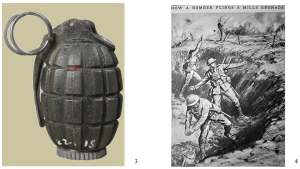Thursday, April 1, 1915
In rest billets northern outskirts of Estaires
The Battalion War Diarist wrote for this day: “6 hours per day training. Trench digging, instruction in wiring and dealing with wire, route marching, practicing attacking with bombs.” [1]
THIS DAY IN RMR HISTORY: “Sir William Mills (1856-1932) of Sunderland was the inventor of the Mills bomb which was developed and manufactured at his factory in Birmingham, England.
The Mills bomb was the hand grenade most widely used by British and Imperial forces during the First World War. He was knighted in 1922.

William Mills was born on 24 April 1856 in Wear Street, Southwick, Sunderland. He was the son of David Mills, a shipbuilder, and his wife Sarah Ann Kirkaldy. It was recorded by the Sunderland historian James Watson Corder that David Mills had an interest in the Sunderland-based Mills shipbuilding firm; however it was actually run by his brothers George and John.
By 1871, William Mills and his family had moved to 22 Camden Street, Sunderland. On the Census taken that year William was recorded as a butcher. However he soon changed careers and began a seven-year apprenticeship with George Clarke, the famous Marine Engineers of Sunderland.
After completing his apprenticeship, Mills spent seven years at sea, obtaining a first class Certificate as a Marine Engineer in 1884.
It was during his time at sea that Mills witnessed great loss of life caused by the unsafe engaging and disengaging methods used on ship lifeboats. The experience prompted him to invent simple, safe and efficient methods, which was first exhibited at the Liverpool Ship-owners Exhibition in 1886.
Mills was awarded a Gold Medal by the Mercantile Marine Service’s Association for his efforts, as well as an Exhibition Gold Medal. The Board of Trade quickly approved his design and it came into worldwide use in both naval and merchant vessels.
Early in 1915, Mills opened the Mills Munitions factory in Birmingham, making the Mills Bomb Hand Grenade. Recognizing the high value placed upon the use of hand grenades in the confined space of a trench, he resolved to design a grenade for use by Sir John French’s British Expeditionary Force (BEF) in France and Flanders 1915. Until then, grenades had often proved as deadly to the thrower as to the intended target. The first grenade used when war broke out in 1914 was a cast-iron canister on an 18-inch stick which was dangerous to use because it often caught on the trench front when lobbed.
There were innumerable types of grenade designed and produced during the war- well over 50, but Mills designed a series that endured and which retains a popular awareness even today. Actually referred to officially as ‘No. 5’, the Mills bomb was introduced in May 1915 and became the dominant British grenade for the remainder of the war. Weighing 1.25 lb, the Mills bomb’s exterior was serrated so that when it detonated it broke into many fragments: thus a fragmentation bomb. To use the Mills bomb the thrower first removed the safety pin while holding down the strike lever beneath it. When the grenade was actually thrown the strike lever ejected and a four-second fuse was set off.
British and Empire soldiers were instructed to lob the Mills bomb using a throwing action similar to bowling in cricket. Classes were taught instructing soldiers how best to do this.
The Mills bomb was improved upon in 1917 with a revised model, No. 36M. This was filled with explosive and then dipped in shellac, which served to seal the grenade and thus prevented rapid deterioration. Its base plug was also strengthened, for use on a rifle discharger (when its fuse was lengthened to a seven second delay).
 Transported in boxes of twelve with detonators carried separately, British soldiers found that they could not readily carry multiple Mills bombs on their person on account of their close fitting uniforms. Their Australian allies, with looser clothing, could carry around half a dozen Mills bombs with reasonable comfort. The British took to carrying green canvas buckets filled with Mills bombs (up to 24 at a time) for use in an attack.
Transported in boxes of twelve with detonators carried separately, British soldiers found that they could not readily carry multiple Mills bombs on their person on account of their close fitting uniforms. Their Australian allies, with looser clothing, could carry around half a dozen Mills bombs with reasonable comfort. The British took to carrying green canvas buckets filled with Mills bombs (up to 24 at a time) for use in an attack.
The detonators were supposed to be attached to the actual grenade before the boxes of grenades reached the front line, however, it was not unusual for a box of Mills bombs to be opened for use only to discover that they were without their necessary detonators.
It has been estimated that during the course of the war approximately 70 million Mills bombs were thrown by allies, with perhaps 35 million other types; a testament to the overwhelming popularity of the Mills bombs itself.
Mills died in 1932 at Weston-super-Mare. He had been married for about 40 years, although his wife died two years before him. He left £37,839 in his will – a relatively small sum for a world-renowned inventor with no children. He received £27,750 from the Government for his Mills bomb invention, but failed in his efforts to avoid paying income tax on the money. Indeed, he claimed to have lost money on the grenade.” [2]
[1] War Diary, 14th Canadian Battalion, The Royal Montreal Regiment, April 1, 1915. Library and Archives Canada, Ottawa, http://data2.collectionscanada.ca/e/e044/e001089714.jpg
[2] Sunderland City Council, Durham, England; http://www.sunderlandfirstworldwar.co.uk/history-notables.html
[3] http://www.canadaatwar.ca/forums/showthread.php?t=2653
[4] http://www.canadaatwar.ca/forums/showthread.php?t=2653

